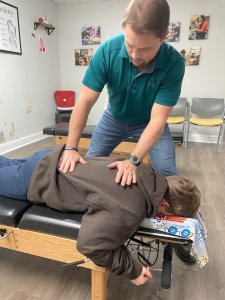As a parent, seeing your teen struggle with unexplained dizziness, fatigue, fainting, and overwhelming anxiety is both heartbreaking and exhausting. Every time they stand up or change positions, you hold your breath, unsure if they’ll stay steady or need to sit down. If your child has been diagnosed with Postural Orthostatic Tachycardia Syndrome (POTS), you’re likely searching for answers to make sense of these challenging symptoms.
stay steady or need to sit down. If your child has been diagnosed with Postural Orthostatic Tachycardia Syndrome (POTS), you’re likely searching for answers to make sense of these challenging symptoms.
POTS affects roughly 1 in 100 teenagers, with girls being 2-3 times more likely to experience it. While you may have heard it’s a genetic condition or received no clear explanation at all, there’s more to this story than genetics alone.
The Nervous System at the Heart of POTS
POTS is deeply connected to your child’s autonomic nervous system (ANS), which governs involuntary functions like heart rate, blood pressure, and digestion. While genetics might play a role, the core issue lies in nervous system dysregulation, particularly involving the vagus nerve.
The Vagus Nerve’s Vital Role
The vagus nerve is a key player in the autonomic nervous system, responsible for:
- Managing heart rate and blood pressure
- Controlling breathing rhythms
- Supporting focus and concentration
- Maintaining overall body balance
Today’s teens are under unprecedented levels of stress from academics, social pressures, and environmental toxins. This relentless stress pushes their nervous systems into a chronic fight-or-flight mode, leaving the vagus nerve overwhelmed and dysregulated.
Dysautonomia and Subluxation
When the nervous system becomes unbalanced, it can lead to dysautonomia—a dysfunction in the ANS where:
- The “fight-or-flight” response dominates
- The calming “rest-and-digest” functions are suppressed
- Multiple systems in the body become dysregulated
Subluxation, or physical misalignments in the spine, can further exacerbate nervous system stress, especially in areas like the upper neck and shoulders.
Why Traditional Testing Often Falls Short
Standard medical tests tend to focus on isolated symptoms rather than evaluating the underlying neurological issues driving POTS. Subtle imbalances in the nervous system, which are key to understanding POTS, often go undetected.
Steps Toward Healing
Understanding POTS as a nervous system condition opens new possibilities for healing and relief. Here’s what parents can do:
- Recognize the Signs: Look for patterns in symptoms, especially related to positional changes or stress.
- Seek a Comprehensive Evaluation: Work with providers who use advanced diagnostic tools, like HRV (Heart Rate Variability) testing, to assess nervous system function.
- Address Physical Tension: Pay attention to stress and tension in the neck, shoulders, and mid-back.
- Support Nervous System Regulation: Chiropractic care can play a pivotal role in reducing interference and restoring balance to the ANS.
The New Hope Chiropractic Approach
At New Hope Chiropractic, we specialize in helping families address conditions like POTS by focusing on nervous system health. Using advanced technology like INSiGHT Scans, we identify and measure neurological imbalances. Our NeuroThermal and HRV scans provide clear data on autonomic nervous system function and allow us to track progress over time.
If your child is navigating the challenges of POTS, don’t hesitate to contact us for a consultation. Not local? Visit the PX Docs directory to find a neurologically-focused chiropractor near you.
Hope for the Future
While POTS is complex, understanding it as a nervous system condition gives parents and teens the clarity and tools to move forward. With the right care, many teens experience significant improvements in their symptoms and overall quality of life.
You’re not alone in this journey—there is hope, and we’re here to support your family every step of the way. ?

